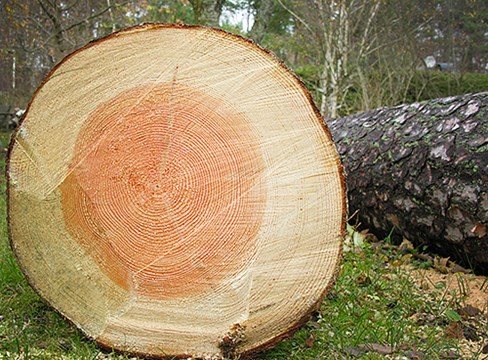Moisture content
Moisture and water have an effect on the properties of wood during both processing and use. The moisture content affects planing, gluing and surface treatment, for example, along with key properties such as dimensions, strength and resistance to degradation (durability). It is therefore important to know how wood is affected by moisture and how to check its moisture content.
The moisture (water) content of wood is measured as the relationship between the moisture content in kg and the amount of dry material in kg. The moisture content, u, is specifically defined as the ratio between the weight of the water in the wet material and the weight of dried wood after drying at 103°C.

Equilibrium moisture content
Wood is a hygroscopic construction material, which means that it is able to absorb and release water vapour from the surrounding air. Wood’s moisture content is thus constantly adapting to the immediate climate around it – damp timber shrinks in a dry environment and dry timber expands in a humid environment. When the moisture content of the wood eventually adapts fully to the ambient conditions, the wood is said to have reached its equilibrium moisture content. The equilibrium moisture content is influenced by the relative humidity (RH) and the temperature, with relative humidity having the greatest impact in the temperature range 0–20°C.
As the climate varies over the course of the year, the wood’s moisture content will also change. Indoors, wood will dry out and shrink during the winter months and then absorb moisture again in the summer.
Relative humidity
The amount of water vapour that the air can hold depends on the temperature. Warm air can hold more water vapour than cold air, so the saturation point rises as the temperature increases. If more moisture is added beyond the saturation point, or the temperature drops low enough, the surplus vapour will condense into water.
The August mists over fields and marshes, steamed up car windows and the moisture under a slice of toast are everyday examples of moist air cooling down so that the water vapour condenses. When the temperature drops after a hot summer’s day, the air also feels damp, although it actually contains the same or less water vapour than earlier in the day. The reason is that the relative humidity has risen.
Relative humidity (RH) is the ratio of how much water vapour the air contains and the maximum that it can hold at the current temperature. Relative humidity is calculated based on the partial pressure of the water vapour, which is the pressure that the water vapour would be at if it alone filled the space.
The effect of the temperature also means that although the vapour concentration outdoors is at its highest in the summer and lowest in the winter, wood’s equilibrium moisture content outdoors is still lower in the summer than in the winter.
Conversely, relative humidity and wood’s equilibrium moisture content indoors are higher in the summer than in the winter, when cold outdoor air is heated, bringing down the relative humidity. The relative humidity of the air indoors in a heated room is therefore highest in summer (45–60%) and lowest in winter (10–25%). The colder it is outdoors, the drier the air indoors.
The moisture content in wood, both indoors and out, adapts to the relative humidity and temperature of its surroundings. In heated homes in mid Sweden, the moisture content in wood averages out across the year at 7.5%, with the highest figures in summer (7–12%) and the lowest in winter (2–6%). On average, it is drier in the north of Sweden than it is in the south, see fig. 45.
Target moisture content
Target moisture content describes the desired average moisture content for a batch of wood and the allowable variation in moisture content between the individual pieces in the batch. The target moisture content is defined in the standard SS-EN 14298:2004 Sawn timber. Assessment of drying quality.
The sawmills dry the wood to different target moisture contents depending on what the wood will be used for. Typical target moisture content on delivery for various products is shown in table 10, page 41. The moisture content on delivery from the sawmill should be adapted either to the continued processing or to the environment in which the product will finally be used. If the wood is too damp on delivery, this can lead to deformation and scrapping at a later stage. If the wood is dried too much, this will cause capacity losses and higher energy costs, and may affect quality and levels of deformation at the sawmill.
The drying process is affected by the property variations between the different pieces of wood and differences in the climate between different parts of the stack in the drying kiln. Density, proportion of heartwood, grain orientation, knots, season and storage period before sawing and drying, are all factors that affect the drying result. This means that there will always be a certain spread of values for moisture content across the pieces in a batch. The average moisture content of a batch and the moisture content of the individual pieces are therefore allowed a certain range of variation in line with table 9, which is part of the standard SS-EN 14298.
Table 9 Target moisture content
Allowable variation for the average moisture content in line with SS-EN 14298
| Ordered moisture content (target moisture content) | Allowable variation in average moisture content for wood batch | Allowable range for the moisture content in 93.5 percent of the pieces in the batch | ||
| % | Lower limit (%) | Upper limit (%) | Lower limit (%) | Upper limit (%) |
| 8 | 7 | 9 | 5,6 | 10,4 |
| 12 | 10,5 | 13,5 | 8,4 | 15,6 |
| 16 | 13,5 | 18 | 11,2 | 20,8 |
When measuring the moisture content of all the pieces in a batch with a target moisture content of 16%, the average value for the moisture content of the whole batch (average moisture content) is allowed to fall between 13.5% and 18% to be approved. As regards the individual pieces in a batch, the moisture content of 93.5 percent of these must fall between 11.2% and 20.8%.
When buying a batch of wood, it is thus important both that the average moisture content is close to the target moisture content and that the moisture content range is narrow, in order for the pieces to lie within the permitted interval.
Moisture content’s variation in the wood’s cross-section
As a result of the drying process, the moisture content will vary in the cross-section of the dried wood. The drying kilns heat the wood and dry out the surface. The movement of moisture from the inner part of the wood to the surface is then determined by the difference in moisture content between those two parts. This means that the surface will always be drier than the inner parts once the drying phase has been completed. The difference in moisture content in the wood’s cross-section is called the moisture gradient.
Depending on what the wood will be used for, the drying process either ends immediately after the drying phase or the wood may be conditioned before it is removed from the kiln. Conditioning involves rewetting the surface to even out the distribution of moisture in the cross-section. The conditioning phase also allows the release of internal stresses that are built up in the wood during drying.
The scale of the moisture gradient is governed by the properties of the wood and the drying process. Immediately after the wood has been dried down to an average moisture content of 16%, for example, the surface of the wood is very dry, often with a moisture content of less than 10%. At the same time, the moisture content in the centre of the wood may still be above 20%. The moisture gradient will gradually even out after drying through diffusion, but the process can take a long time, particularly in low temperatures. The surfaces of the wood can be moistened from the outside if the wood is stickered and stored outdoors, resulting in less of a gradient.
Unconditioned wood with a large moisture gradient can lead to deformations if the wood is resawn or the cross-section is significantly changed, for example through profiling. If, on the other hand, the wood is going to be used with essentially the same cross-section as during drying, for example as wall studs, a large gradient with an accompanying low surface moisture content can provide good protection against microbial growth. See the section Microorganisms.
Accurately measuring the moisture gradient or surface moisture content is difficult. Both the gradient and the surface moisture content can, however, be estimated with the help of an electrical resistance moisture meter with insulated hammer electrodes, see section on Measuring the moisture content below.
Sawmill conditioned wood
The wood is conditioned in order to reduce the moisture gradient and the internal stresses caused by the drying process. Water or steam is added to the drying kiln in order to moisten the surface of the wood. Adding heat and moisture at the same time releases any internal stresses.
Wood that is to be re-sawn at a later stage should have the stresses and moisture content evened out in the cross-section. If wood with internal stresses is re-sawn or profiled, deformations will occur immediately during the processing. If wood with a high moisture gradient is re-sawn, the deformations will occur later as the moisture content in the wood evens out. Conditioned wood products are necessary for the joinery industry in order to make efficient use of the material and achieve high quality joinery products.
The conditioning can also achieve less of a variation in the moisture content since the wetter pieces of wood in the drying batch absorb less moisture than the dry ones, or even continue to dry a little during the conditioning. The conditioning improves the dimensional stability of the wood and reduces the risk that the finished wood product will change shape after the drying process. In addition to having the right target moisture content, construction timber is also improved if the above quality parameters are used. Floor joists and structural timber, for example, become more dimensionally stable if the wood is evenly stressed.
Internal stresses are assessed using the slicing method described in the standard SS-ENV 14464.
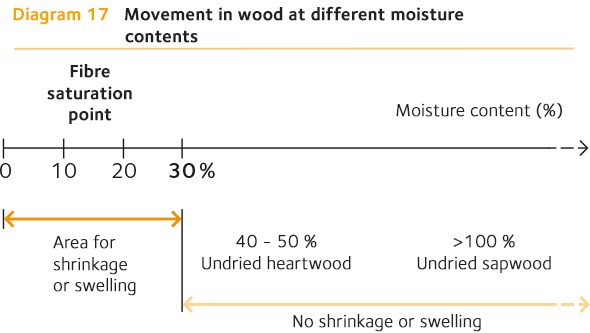
Fig. 49 Movement in wood at different moisture contents
Measuring average moisture content
Measuring a piece of wood’s moisture content provides a value for the average moisture content of the cross-section. The average moisture content in a piece of wood can be determined using the dry weight method or estimated using an electrical resistance moisture meter. The resistance moisture meter should have hammer electrodes with insulated probes. With insulated probes that can be pushed deep into the wood, it is possible to accurately decide where in the wood to measure the moisture content, which allows you to determine the moisture gradient in the wood, for example. Other types of electrical moisture meter give much less accurate measurements. Moisture content meters with short, uninsulated probes can only give an indication of the surface moisture content, which may differ substantially from the average moisture content of the piece. Such meters should therefore only be used to check surface moisture content, for example before painting. Capacitive moisture content meters that you place against the surface of the wood are influenced by the surface moisture content, but the measurements can also be adversely affected by electrically conductive materials near the piece of wood, such as a steel beam underneath it.
The dry weight method involves first weighing a piece of wood, drying it in an oven at 103 ± 2°C until its weight changes by no more than 0.1% in two hours, and then weighing the whole dry piece of wood again. The moisture content is then calculated using the formula above, see page 36. The method described in standard SS-EN 13183-1 Moisture content of a piece of sawn timber – Part 1: Determination by oven dry method is both the actual definition of moisture content and the only practical method of precisely establishing the moisture content. The downside is of course that the method destroys the sample and takes a relatively long time.
A simpler, faster and non-destructive way of measuring the moisture content is to use an electrical resistance moisture meter with insulated hammer electrodes. Handheld electrical resistance moisture meters with insulated hammer electrodes usually work on the principle of measuring the resistance between two insulated probes that are inserted into the material. The disadvantage of resistive moisture content measurements is that the accuracy is poor since the measurement is affected by both the density of the wood and its other properties. In addition, the results are affected by how the meter is used – for example, the moisture gradient means that even a small difference in insertion depth can have a major impact on the results. Overall, this means that an electrical resistance moisture meter with insulated hammer electrodes can only be expected to produce a result that is within around ± 2% of the true moisture content of a particular piece of wood. Electrical resistance moisture meters with insulated hammer electrodes are therefore best for estimating the moisture content of a batch rather than the values for individual pieces. Resistance moisture measurements should follow the method described in standard SS-EN 13183-2 Moisture content of a piece of sawn timber – Part 2: Estimation by electrical resistance method.
An alternative to a resistance moisture meter involves measuring the capacitance beneath a transmitter and receiver in the instrument. Capacitance moisture measurements should follow the method described in standard SS-EN 13183-3 Moisture content of a piece of sawn timber – Part 3: Estimation by capacitance method. A key advantage of these meters is that they do not cause any damage to the wood, as they have no probes to insert. A hand-held capacitive meter is, however, much less accurate than a resistive meter due to several factors: the electrical field used for a capacitance measurement reacts most to the material nearest to the instrument, which means that surface moisture has a greater effect than the inner parts of the wood; the results are affected by how hard the sensor is pressed against the wood, by nearby pieces of wood and by the proximity of metal objects. A hand-held capacitive moisture meter should therefore only be used for tests and checks, and not to determine the moisture content of wood.
Fixed capacitive moisture meters are used effectively on sawmills’ trimming lines and in planing mills to monitor production. These devices enable all the wood to be monitored and disruptions in the production process to be quickly identified. Some moisture meters on the production line compensate for the wood’s total density, which improves the accuracy of the measurements, but the precision is still not good enough to measure individual pieces of wood.
Measuring moisture content using the resistance method
Used correctly, an electrical resistance moisture meter with insulated hammer electrodes is an effective tool for measuring wood’s moisture content. The device can be used to determine a batch of wood’s average moisture content and variation, estimate surface moisture content and moisture gradient, monitor moisture conditions during construction or check the moisture content in existing structures.
The function of the electrical resistance moisture meter with insulated hammer electrodes should be regularly checked using a calibration block.
Determining the moisture content of a piece of wood
To reduce the effect of the way the meter is used, standard SS-EN 13183-2 sets out how the insulated hammer electrodes should be inserted into the piece of wood. The average moisture content of wood is measured as follows: measure 300 mm from the end. Insert the insulated hammer electrodes into the face of the wood, in the direction of the grain, and along an imaginary line running 0.3 times the width of the wood in from the edge. The measurement depth should be 0.3 times the thickness of the wood, see fig. 50.
Determining the average moisture content and variation in a batch
To determine the average moisture content and variation in a batch of wood, the moisture content needs to be measured across a number of pieces in the batch. The number of samples and the selection process depend on the size of the batch. Two standards describe wood acceptance checks: SS-EN 14298 Sawn timber. Assessment of drying quality and SIS-CEN/TS 12169 Criteria for the assessment of conformity of a lot of sawn timber. The standards are very similar in content. Sampling and analysis procedures are described in more detail later in this text, but the number of packs and samples to be measured is the same.
SS-EN 14298 focuses on drying quality and states requirement limits for average moisture content and for individual values, the number of samples that should be taken depending on the size of the batch, and how many measurements are permitted to exceed the requirement limits. For the batch to be approved, the average moisture content must fall within the limits for the required target moisture content, and the number of measurement values outside the moisture content limits must be below the maximum number. Standard SS-EN 14298 requires a relatively large number of measurements – for example, in a batch of 91–150 planks, the moisture content of 20 pieces should be measured, three of which are permitted to exceed the requirement limits. Surface hardness or residual stresses in the wood are to be determined using the method described in SS-ENV 14464 Sawn timber. Method for assessment of case-hardening. The method is also called the slicing test, as a cross-section of the wood is sliced open and the gap between the two halves is measured.
SIS-CEN/TS 12169 gives a general description of how to take samples from a batch of wood in order to check that the batch matches the specifications in the contract or building description. The method is based around the use of the most common control method for all industries, Acceptable Quality Level (AQL). An acceptance check involves randomly selecting a set number of sample boards or planks, depending on how many boards or planks are contained in the batch. The standard sets out what deviations are allowable, depending on the chosen quality level.
Note The whole content of the wood package must be made available in the event of a complaint.
Recommended target moisture content for delivered wood products
Table 10 states the target moisture content for deliveries of wood products for different applications.
Table 10 Target moisture content for deliveries of wood products for different applications
| Target moisture content (%) | Application |
| 8 | Floorboards indoors in heated rooms |
| 12 | Exposed cladding, mouldings and subfloors in heated rooms |
| 16 | Solid wood and glulam for encasing and exterior cladding |
Determining the moisture gradient
Only the very tips of the insulated hammer electrodes on an electrical resistance moisture meter have electrical contact with the wood. This makes it easy to determine the moisture gradient in the wood by first using the probes to measure the moisture content of the surface wood and then inserting them to a depth of 0.3 times the thickness. The difference in the values gives a measure of the total moisture gradient.
Determining surface moisture content
It is important to check the surface moisture content since it has a major impact on paint adhesion and is critical for the risk of microbial growth, not least during encasing.
Note
There is no Swedish or European standard for measuring the surface moisture content of wood. The following method is taken from the SP Trätek handbook Fukt i trä för byggindustrin – Fuktegenskaper, krav, hantering och mätning.
Measure the surface moisture content with an electrical resistance moisture meter with insulated hammer electrodes by pressing the conical jacket of the insulated hammer electrode tips down into the springwood of the surface by hand, so that half the jacket of the electrode tips makes an impression in the wood, going across the grain. Always take three measurements close to each other at the measuring point and then work out an average. The average can then be checked against the relevant requirement.
Wood delivered dried from sawmills always has a surface moisture content below risky levels, but the wood may have become damp due to rain, incorrect storage or the wood being placed in contact with damp concrete, giving it an elevated surface moisture content. The moisture content in the inner part of the wood will not normally be affected by short-term exposure to damp. Moisture content in the inner part of the wood will also not affect the surface moisture content, since the pace of moisture wicking out through the wood is much slower than evaporation from the surface. Wood exposed to water must be dried out. Depending on the level of wetness, this can be done naturally, with a dehumidifier or with a construction fan. The surface moisture content must be no more than 18% when encasing and max 16% when applying a surface treatment.
Recommended surface moisture content when painting
Wood that is to be painted on the construction site should be primed as quickly as possible to protect against UV radiation, and the surface moisture content should be max 16% when painting. It is recommended that exposed wood such as external cladding and interior casings should be given an industrial surface treatment in accordance with the third-party certified quality assurance system CMP (Certifierad Målad Panel = certified painted cladding). External cladding that is primed at the construction site should have a film thickness, expressed as the amount of paint applied per square metre, averaging at least 60 μm (micrometres) as a dry layer.
Measuring moisture content in buildings and existing structures
Checking the moisture content in wood involves measuring the level at different points in the structure in question. The measuring points are determined by conditions on site. Seek out the places where the risk of damp is greatest and drying conditions poorest. Work out the surface moisture content and the average moisture content in the wood at the measuring point.
Irregularities in moisture content measurements using the resistance method mean that a single high measurement value may have been caused by factors other than moisture. If a point appears to have a high moisture content, the cause will need closer investigation. More measurements should be done in the wood around the suspicious point, and tell-tale signs other than the moisture content value such as visible damp, mould and smell should be taken into account. Conduct an assessment of how vulnerable the section of wood is, and has been, to damp, and how well ventilated the structure is. Dry weight samples should be extracted if necessary.
Lists of standards
To ensure that everyone measures moisture content and drying stresses in wood in the same way, there are now four standards:
- SS-EN 13183-1 Moisture content of a piece of sawn timber – Part 1:
Determination by oven dry method. - SS-EN 13183-2 Moisture content of a piece of sawn timber – Part 2:
Estimation by electrical resistance method. - SS-EN 13183-3 Moisture content of a piece of sawn timber – Part 3:
Estimation by capacitance method. - SS-ENV 14464 Sawn timber. Method for assessment of case-hardening.


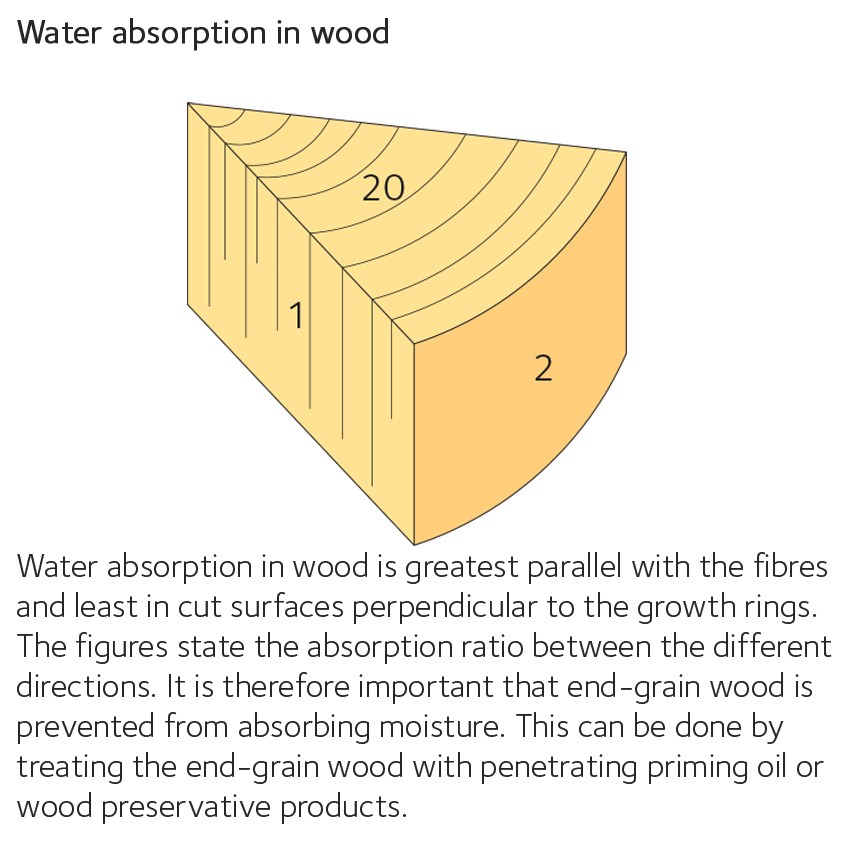
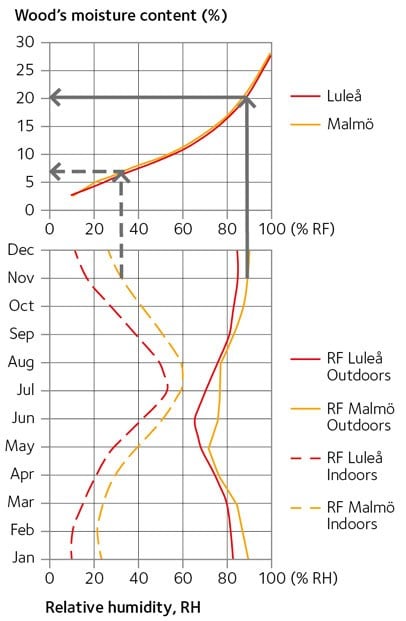
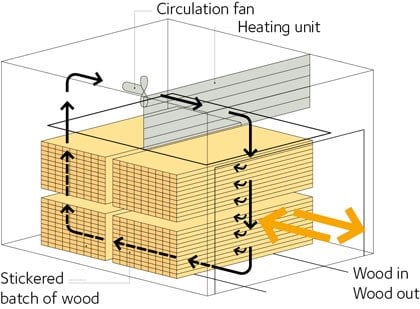
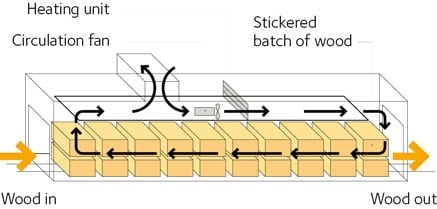
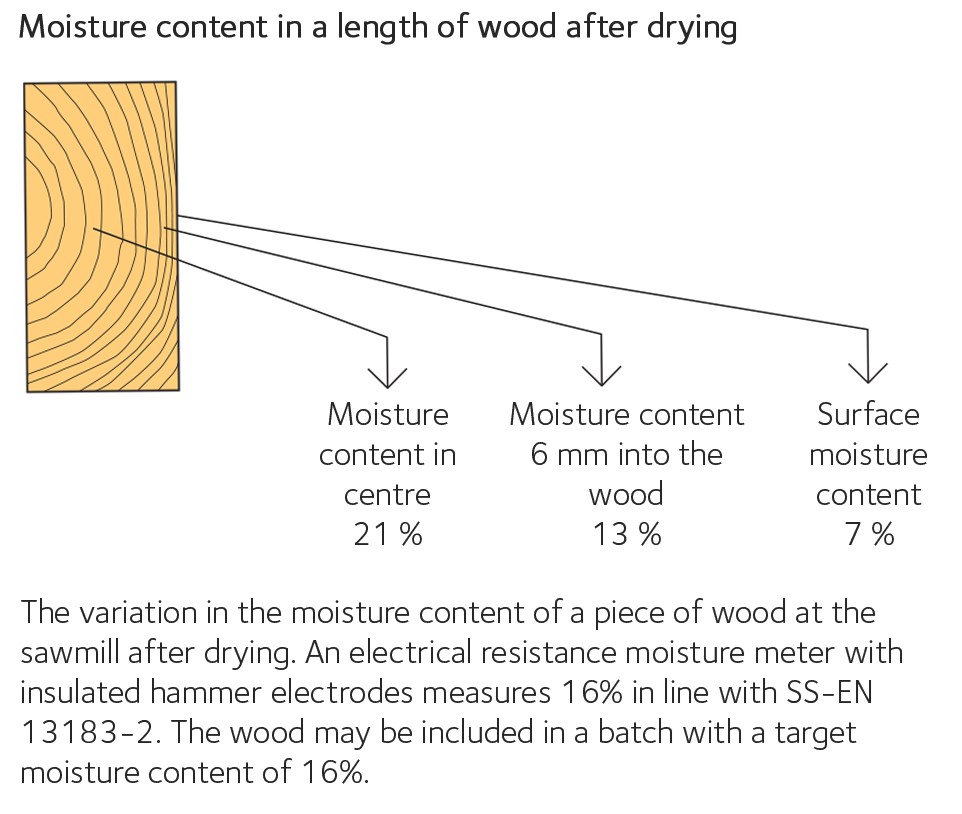
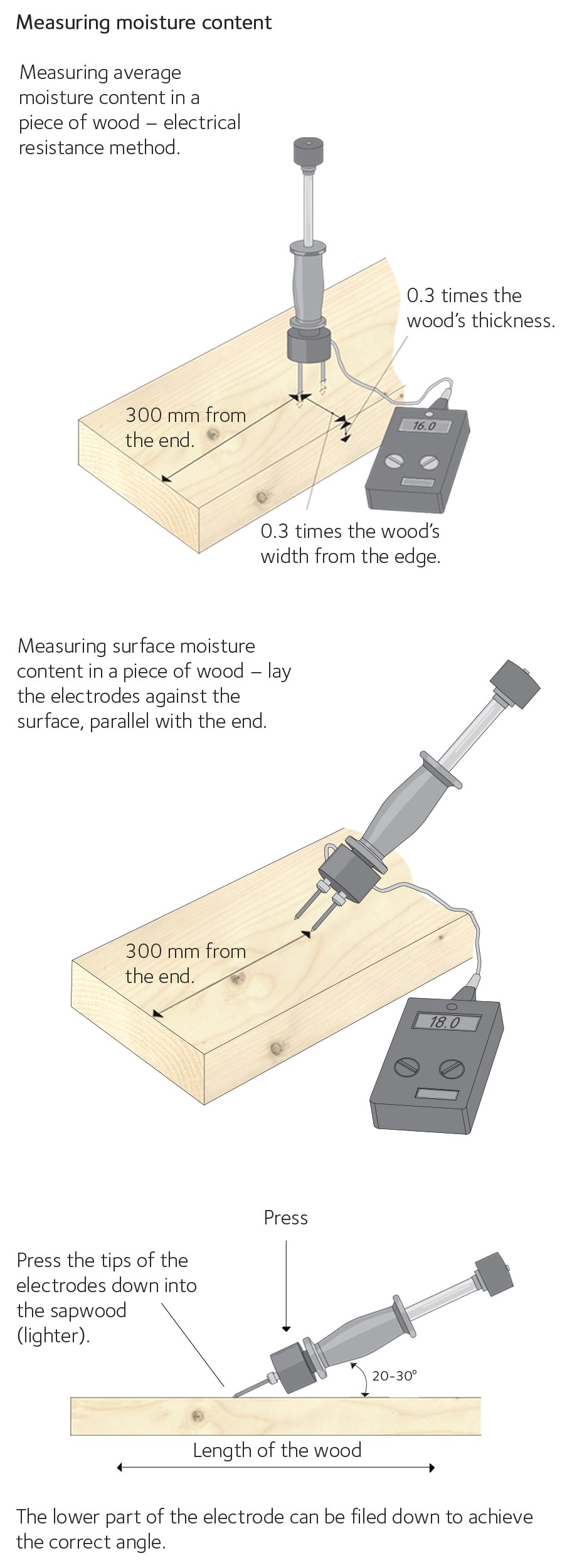
 Kayak House, Lisö, Sorunda.
Kayak House, Lisö, Sorunda.
